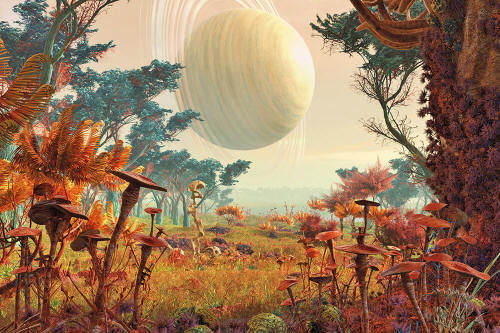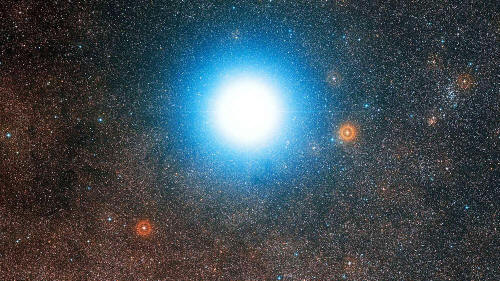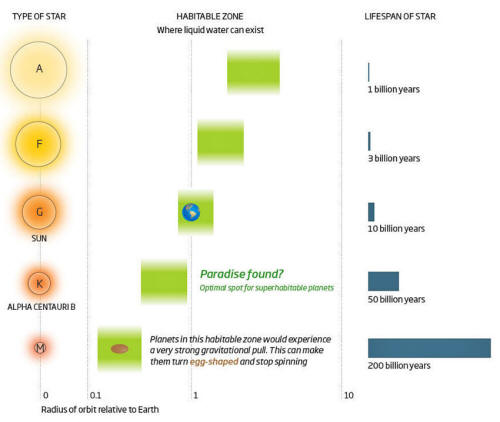|
by MacGregor Campbell May 21, 2016 from Sci-Hub Website
Planets even balmier than our own could be just a cosmic stone's throw away,
finds MacGregor
Campbell
Earth and the solar system have always been our benchmarks for life-friendly environments. No longer. The system next door might trump ours, while observations further afield are forcing a fundamental rethink of where life can flourish.
One of the things he discovered about it while growing up in Chile was that our closest neighboring light had a secret:
More than 30 years later, Eduardo Bendek, now an astronomer at NASA'S Ames Research Center, suspects that his favorite celestial beacon might just be hiding another, more marvelous secret. There could be a planet orbiting one of the stars. And not just any old space rock.
This could be a place so bursting with
life that it makes Earth look post-apocalyptic.
How could we expect more than a
self-replicating bag of biomolecules anywhere else?
Time was perhaps the most important attribute identified by astrophysicist René Heller of the Max Planck Institute for Solar System Research in Gottingen, Germany, when in 2015 he was considering the factors that make a planet more habitable than Earth.
Habitability isn't just about having the correct balance of temperature and chemicals. Life takes eons to get started, so it's also about how long those persist.
The sun is a
G-type star, the
third smallest variety. So planets orbiting diminutive K and M-type
stars can expect longer lives.
And to host this life-giving stuff, planets should ideally reside in a habitable zone:
The habitable zones of M-type stars must be far closer in than in those of warmer stars like our own.
So snug, in fact, that the star's gravity is likely to wreak havoc on any planets. The difference between the gravitational tug on the front and back of the planets can deform them into an egg-shape, which eventually stops them spinning. Hardly ideal for life.
A K-type star, on the other hand, would have just the right conditions.
And that's exactly what
Alpha
Centauri B, the smaller star of the pair, is.
Alpha Centauri is a star we could conceivably visit.
Rocky planets like Earth can have liquid metal
cores, a boon for life because it drives plate tectonics, which in
turn refreshes atmospheric gases.
In 2012 Xavier Dumusque at the Harvard Smithsonian Center for Astrophysics and colleagues turned their telescope on the star, looking for the characteristic wobble caused by a planet's gravitational tug.
They found evidence for a
planet about 10 per cent larger than Earth with an orbit of just
over three days.
Last year, Suzanne Aigrain at the University of Oxford showed that the wobble Dumusque spotted was almost certainly a measurement error. Still, that is no reason to give up hope.
NASA's Kepler telescope, which hunts for exoplanets in the Milky Way, has found so many that a star without one now seems unusual. Many are "super-Earths" - precisely the large rocky worlds that fit the bill for super-habitability.
Plus, Christophe Lovis at the
University of Geneva says measures of the star's wobbles rule out
any gas giant planets orbiting close to it.
To know for sure we need pictures, so Bendek and Ruslan Belikov have proposed a mission to get them.
To snap an exoplanet, you need a
telescope equipped with a coronagraph, a shade that blocks the
blinding glare from the parent star. Alpha Centauri's two stars make
things even more difficult.
So Bendek and Belikov came up with an instrument they call ACESat. This would suppress both stars' light using a coronagraph in conjunction with a deformable mirror.
Subtle ripples in the mirror deflect the light of each star separately, and simulations show it would be able to reveal Earth-sized planets in the habitable zone of either one.
That is small enough to fly into orbit
at what is, in space freight terms, rock bottom price.
The lifetime of stars varies according to their size. Both M- and K-type stars live longer than our sun, which would give planets orbiting them longer to develop life.
But which is the perfect place to hunt
for a habitable world? A mission focused on just two stars is simply too chancy for it, says Bendek. In contrast, the Kepler mission has surveyed more than 100,000 stars.
In terms of funding,
Undeterred, Bendek and Belikov are exploring private financing.
That may not be a bad move. After all,
Russian billionaire and physicist
Yuri Milner has already
hatched a plan to visit Alpha Centauri. Announced last month, the
Breakthrough Starshot initiative plans to send a tiny spacecraft
there.
The plan involves accelerating the craft to
20 per cent the speed of light by equipping it with a solar sail and
pushing it with a giant Earth-based laser.
And we
have a fantastic reason to make the trip.
|




